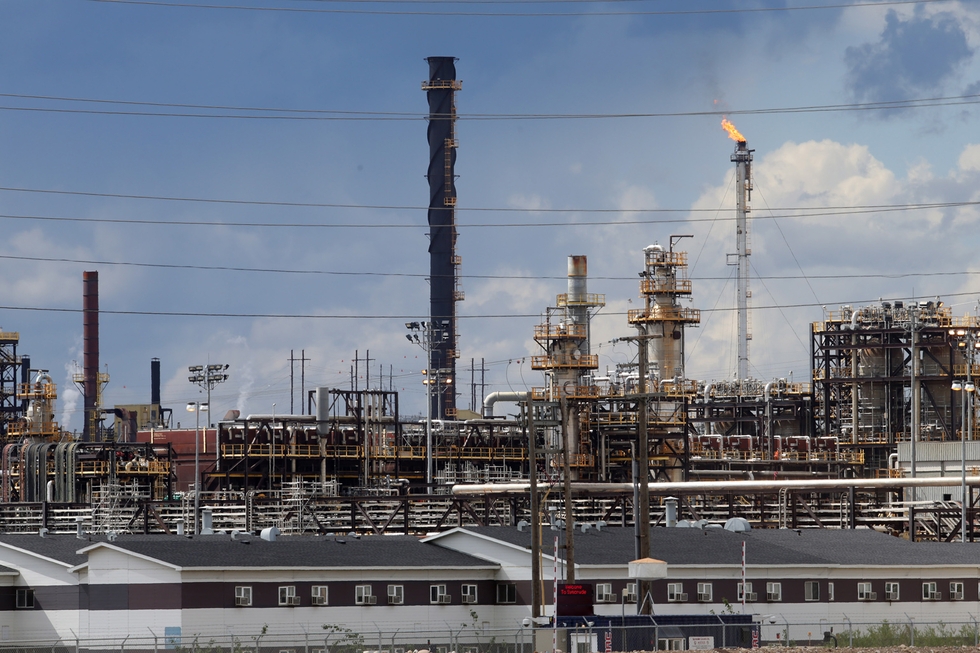ANALYSIS: Canada to make gains as OPEC oil production slows

TORONTO, Canada – After months of negotiations and uncertainty, the world’s largest oil producers agreed late last year to curb global oil production in 2017. The deal, reached between OPEC and non-OPEC states, comes after two years of over-production that pushed global oil prices into a downward spiral.
And while it was not a party to the agreement, Canada may have a lot to gain from the slowdown, especially as Saudi Arabia, the main producer in the Organization of the Petroleum Exporting Countries, cuts production.
“I think Canada is going to be one of the winners to walk away from all of this,” said Samir Madani, co-founder of TankerTrackers.com, a website that tracks seaborne oil tankers and barrels, and government oil statistics.
“Because they are not in the agreement and they are the single largest supplier to the United States, they are the lifeline to the US, in that regard,” Madani told Middle East Eye. “Canada is growing more and more efficient when it comes to energy.”
Signed in Vienna on 30 November, the OPEC countries are to cut 1.2 million barrels of oil per day (bpd) starting in the new year. Oil prices immediately jumped as a result, as did the currencies of some large oil-producing states, Bloomberg reported.
'Canada is growing more and more efficient when it comes to energy' - Samir Madani
About a week later, non-OPEC countries also entered into an agreement with OPEC – the first since 2001 – to slash their own production by 558,000 bpd.
"This agreement cements and prepares us for long-term cooperation," Saudi Arabia’s Energy Minister, Khalid al-Falih, told reporters after the December meeting.
As the largest exporter in OPEC, Saudi Arabia is expected to cut as much as 486,000 bpd from the overall OPEC output reduction, according to Reuters. Russia, meanwhile, is expected to cut 300,000 bpd.
“It’s now as of January 1 that they should all start cutting back, those who agreed to it. How much they will cut is up to them, but as long as they reach within the six-month period what they’ve committed to, then that’s the target,” Madani said.
Canadian crude
Other experts agree that the deal could finally signal good news for Canadian producers, many of which have struggled in the face of declining oil prices.
“Everyone in the oil patch… I’m sure they’re cheering for every production cut that OPEC can muster,” said Jordan Brennan, an economist at Unifor, Canada’s largest private sector union.
Canada’s oil exports are primarily made up of heavy crude oil derived from the tar sands in the western province of Alberta.
In the last few years, the dwindling price of oil has dragged down the Canadian dollar – the loonie – as the country’s economy has become tightly bound to any fluctuations in the global oil industry.
Canada’s break-even point for the cost of producing a barrel of oil is also much higher than that of other oil-producing states, because production in the country's tar sands requires higher up-front costs. The way Canadian oil is produced is really energy intensive, making it costlier to produce. This means that Saudi Arabia, for instance, can better withstand a lower price per barrel than Canada.
Between the end of 2014 and mid-2016, about 30,000 jobs were lost in Canada’s oil and gas industry as a result of the price downturn, according to government and industry estimates.
But Canada remains the largest supplier of crude oil to the US.
“Canada is far more important from the standpoint of American consumption than the Middle East,” Brennan told Middle East Eye. “Even though our minds automatically take us to the Middle East, when you think about the global oil industry, the US is far more dependent on Canada.”
Indeed, Canada has been the US’s biggest crude oil supplier since 2004, and four out of every 10 barrels of oil imported into the US in 2015 came from Canada. That year, Canada set a record by exporting 3.2 million barrels per day of heavy crude into the US, making up 43 percent of total US crude oil imports.
'Even though our minds automatically take us to the Middle East, when you think about the global oil industry, the US is far more dependent on Canada' - Jordan Brennan
“We’re only a third the size of Saudi Arabia or the United States roughly speaking in terms of production, but Canada’s oil production is still larger than Iraq, which is the second largest in OPEC,” Brennan said.
Canada also takes in most of the US’s crude oil exports, the US Energy Information Administration found, of about 422,000 barrels per day.
US production of crude has jumped dramatically since President Barack Obama lifted the ban on global oil exports in late 2015. For nearly four decades, US crude could only be exported to Canada.
The Trump effect
The election of Donald Trump as the next US president may also prove beneficial to Canada’s oil industry, according to Anna Zalik, an associate professor at York University in Toronto specialised in global environmental politics and development studies.
Trump has already spoken in favour of the Keystone XL pipeline, a project that was shelved by the Obama administration that would send Canadian crude to refineries and distribution centres in Texas, Oklahoma and Illinois.
Zalik said that since oil prices are influenced in large part by perceptions, any perceived instability in the global economy could send prices soaring, which benefits Canada in the end.
“If one of the outcomes of the change in regime in the US is greater insecurity and hostility with the Middle East, then prices could go up again and that ultimately would benefit the Canadian economy or would benefit the oil industry,” she told Middle East Eye.
“That’s where I think Canada could benefit if there’s increased tensions between the US and the Gulf, which is a possible outcome of this new regime.”
According to Madani, the main challenge for Canadian oil producers thus far has been getting their supplies to foreign markets. With the Saudis cutting oil production and exports, forcing prices to go up, Canada is in a prime position to fill that void by boosting oil exports to other countries, particularly the US.
“The output from Canada I think will rise by another 20 percent over the next three or four years… There are some very strong projections there. I think what’s actually holding it back is the pipeline infrastructure rather than anything else,” he said.
In recent years, opposition has steadily grown across Canada to government plans to build oil pipelines to the US and to the east and west coasts of the country for export abroad. Late last year, Prime Minister Justin Trudeau gave the greenlight to two contentious oil pipelines.
But concerned citizens, environmental groups, and Indigenous communities have joined forces to challenge these pipelines both in court and through public protests. First Nations communities have also vowed to block their construction.
Still, Trudeau may be more successful than his predecessor, former Conservative leader Stephen Harper, in getting pipelines built because he is “cleaning up Canada’s image globally” on the environment, Brennan said.
“It gets back to perception,” Brennan said, “[and] that for the people who want to increase Alberta’s energy production, a government that commits itself to the Paris Agreement and has a credible plan for reducing emissions may be more successful in getting more pipeline infrastructure built.”
New MEE newsletter: Jerusalem Dispatch
Sign up to get the latest insights and analysis on Israel-Palestine, alongside Turkey Unpacked and other MEE newsletters
Middle East Eye delivers independent and unrivalled coverage and analysis of the Middle East, North Africa and beyond. To learn more about republishing this content and the associated fees, please fill out this form. More about MEE can be found here.




